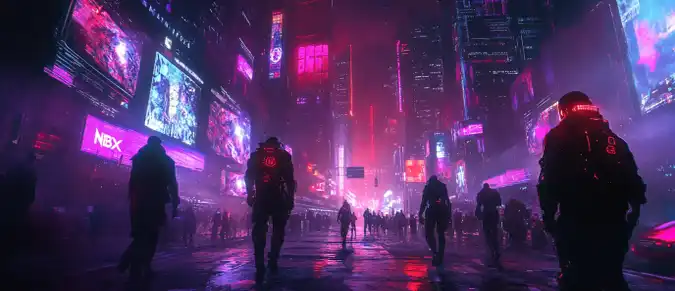MARBLEX — is a blockchain ecosystem created by Netmarble to integrate Web3 technologies into the gaming industry. The project connects traditional games and decentralized solutions, offering players tokens, NFTs, and access to new forms of monetization. Its goal — to create an environment where gameplay and fun remain the priority, while blockchain enhances the value of content and interaction.
An additional advantage of MARBLEX is the support of Netmarble’s vast community, which immediately ensures scalability. This gives the platform the opportunity to compete with Web3 gaming leaders and form a sustainable ecosystem.
- History and Mission of MARBLEX
- Architecture and Technical Infrastructure
- MARBLEX`s Tokenomics and Financial Model
- Gaming Content and Development Plans
- Community, Marketing and Growth Strategies

History and Mission of MARBLEX
MARBLEX was founded as a subsidiary of Netmarble, one of the largest mobile game publishers in the world. The main task of the project — is to combine traditional gaming experience with the possibilities of Web3, without sacrificing fun for financial instruments. The company’s motto — «Fun Comes First» — emphasizes that gameplay comes first, while blockchain serves only to enhance engagement. MARBLEX aims to be a bridge between casual players and the crypto community, offering convenient tools for both developers and users.
In addition, the platform follows a «mass adoption» strategy, where priority is given to user-friendliness for newcomers rather than complex DeFi mechanics. This makes it attractive not only to experienced crypto enthusiasts but also to players encountering Web3 for the first time. In this way, MARBLEX lowers entry barriers, opening the way to the gradual gamification of the blockchain industry.
Architecture and Technical Infrastructure
MARBLEX builds its system on a hybrid model that combines the Klaytn blockchain and Google Cloud services. This approach allows the platform to ensure high performance, fast transactions, and convenient tools for developers. The architecture clearly defines layers responsible for different tasks — from supporting specific games to global decentralization.
| Component | Function |
|---|---|
| Game Service Chain | Supports specific games and their tokens |
| Bridge Chain | Conversion and transfer of assets between services |
| Public Chain | Main layer on Klaytn, ensuring transparency and decentralization |
| Google Cloud API | Provides developers with access to blockchain data and analytics |
This architecture allows the processing of large transaction volumes and integrates blockchain functions into games without performance losses. In addition, MARBLEX uses BigQuery and Compute Engine for data analysis and developer support.
The infrastructure is also built with a focus on security, including reliable key management systems and smart contract audits. This ensures trust from both players and partners working within the ecosystem. Such an approach allows MARBLEX to serve millions of users simultaneously without losing stability.
MARBLEX`s Tokenomics and Financial Model
The financial model of MARBLEX is designed so that all gaming projects in the ecosystem are connected by a shared economy. This solves the problem of fragmented in-game currencies and creates a unified value space for users. With this approach, players can freely move assets between different games, preserving their significance and liquidity. The financial model of MARBLEX is built on three levels:
-
Game Tokens — in-game currencies for specific projects.
-
MBXL — an intermediate bridge token used for conversion.
-
MBX — the main public token of the ecosystem.
This scheme makes it easier to transfer value between games and reduces competition for player attention. For example, tokens from one RPG can be used in other Netmarble products, which enhances economic stability and engagement.
Furthermore, Union Tokenomics creates synergy between games, helping them grow not in isolation but within a unified system. This prevents inflation of individual tokens and supports long-term stability. Such a model benefits both developers and players by creating a sustainable gaming market.
Gaming Content and Development Plans
In 2025, MARBLEX expands its Semi-Publishing model by collaborating with external studios and providing support for Web3 integration. A number of releases are already planned: from the business simulator Self-Made Billionaire to RPG projects Mercenary Children, Meta Toy DragonZ SAGA, and PROJECT X. Special attention is given to progressive NFTs: they retain their value even after games shut down and can be transferred to other products. This approach creates a more sustainable gaming economy and builds user trust.
MARBLEX is also developing the concept of «games as a service,» where updates and events will regularly maintain audience interest. This will allow the creation of long-living franchises in the Web3 environment. In the long term, the company aims to cover not only mobile projects but also console and PC games.
Community, Marketing and Growth Strategies
MARBLEX actively builds its community through Creator M programs, collaborations with influencers, and hosting events. Notable examples include the Web3 developer contest «Hack the FUN» with a $1M prize pool and the rebranding with mascot gObY, symbolizing the philosophy «Fun Comes First.» The company has also established a $20M fund with Immutable to support studios and promote Web3 games. These steps strengthen MARBLEX’s position as one of the leaders in GameFi, focused on long-term development and a broad audience.
In addition, the team emphasizes localization and regional outreach to maximize audience coverage. This enables the project to compete globally and attract millions of new users. The combination of marketing, branding, and technical infrastructure ensures sustainable growth and a long-term development strategy.




